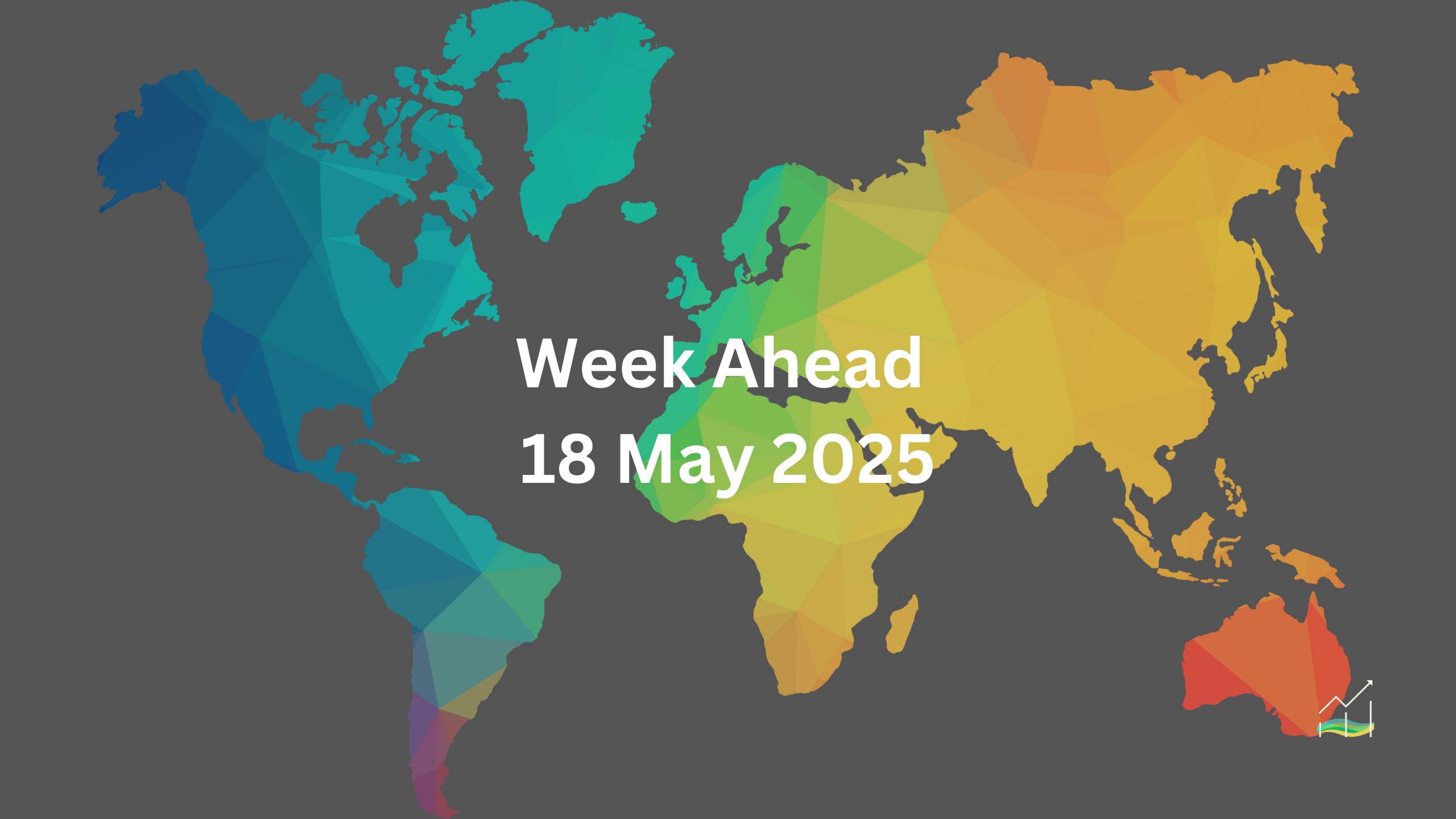18/05/2025 Week Ahead

Dollar Holds Firm as Global Policy Divergence Deepens
Key Takeaways:
- The US dollar closed the week stronger against all G10 currencies, despite weaker US data.
- Markets now expect the Fed's first rate cut to come in Q4, later than previously projected.
- Moody’s downgraded the US credit rating, mirroring earlier moves by S&P and Fitch.
- Tariff relief between the US and China has led to a spike in shipments and imports.
- Global inflation dynamics diverge: UK inflation is expected to rise, Canada to fall, and Mexico remains uncertain.
- RBA and Chinese central bank decisions may lead to further policy easing.
- Flash PMIs and Powell’s remarks on data divergence will shape sentiment this week.
The US dollar ended last week on a strong footing, advancing against all G10 currencies despite a string of softer US economic data. Weak retail sales, subdued manufacturing output, and below-forecast inflation figures did little to halt the greenback’s upside correction. The shift in market expectations — now pushing the first Fed rate cut into the fourth quarter — continues to support the dollar’s resilience. With most G10 central banks still projected to cut ahead of the Fed, the divergence in monetary policy remains a dominant theme.
Fresh momentum in global trade followed the 90-day suspension of US and Chinese punitive tariffs, triggering a surge in shipping volumes and import activity. This influx may artificially inflate consumption and inventories, muddying the underlying economic picture. Meanwhile, the Atlanta Fed’s GDPNow estimate places Q2 US growth at 2.4%, which, if realised, would be the highest among G10 peers.
In a symbolic move, Moody’s downgraded the US credit rating, echoing earlier actions by S&P and Fitch. While the immediate market reaction was muted, the announcement underscores long-standing concerns over unsustainable fiscal policy. Despite foreign investors continuing to absorb US debt, rising interest costs and the failure to advance the latest federal budget proposal highlight fiscal vulnerabilities.
Looking abroad, the Reserve Bank of Australia is expected to cut rates again, with two more cuts priced in for the remainder of 2025. China may ease policy further through loan prime rate adjustments following last week’s repo rate cut. In contrast, UK inflation is likely to jump due to energy and water price increases, while Canada’s headline inflation is expected to fall below 2%. In Mexico, the central bank has opened the door for another 50 bp rate cut, pending upcoming inflation data. Preliminary global PMIs and Fed Chair Powell’s comments on the gap between hard and soft data will also draw attention in the days ahead.
United States of America
Overview
The US dollar has rebounded sharply after months of weakness, supported by rising Treasury yields and shifting market sentiment. From mid-January through late April, the dollar had broadly sold off, but a clear turn in momentum emerged in recent weeks. The catalyst includes the market’s renewed alignment with the Federal Reserve’s forward guidance, despite ongoing softness in key real-sector indicators like retail sales and manufacturing output. The 90-day easing of trade tensions between the US and China also contributed to improved risk sentiment and reduced recession expectations.
Moreover, the potential revision of the Supplemental Leverage Ratio — a key regulatory requirement — is helping to stabilize the US Treasury market, even as the ECB has encouraged European banks to scale back their dollar funding needs. Meanwhile, Chair Powell continues to push back against the narrative of economic weakness implied by soft survey data, arguing that real-sector indicators remain relatively firm. As the week progresses, upcoming surveys and housing data will likely be viewed as secondary to the broader macro picture and policy trajectory.
Economic Drivers
- Rising US Treasury yields have supported the dollar’s recovery.
- Markets have re-aligned with Fed policy expectations, delaying rate cut pricing to Q4.
- Weaker retail sales and manufacturing data have not shifted the broader macro outlook.
- Easing of US-China tariff tensions has lowered perceived recession risk.
- Indications of a potential revision to the Supplemental Leverage Ratio are stabilizing Treasury markets.
- The ECB’s push for reduced dollar funding among EU banks may reduce European demand for USD.
- Fed Chair Powell maintains that hard data is more reliable than recent soft surveys.
Data and Events
- 22 May 2025: Unemployment Claims.
- 22 May 2025: Flash Manufacturing & Services PMI.
- 22 May 2025: Existing Home Sales.
- 23 May 2025: New Home Sales.
Price Action
- The Dollar Index posted its fourth straight weekly gain, nearing a 61.8% retracement of its previous decline.
- Momentum indicators are still rising but approaching overbought levels.
- Initial support lies near 102.00–102.10; broader trendline support is around 100.15.
Key Points:
- Dollar strength is supported by rising yields, Fed policy repricing, and macro stability.
- Powell continues to discount soft survey data in favour of hard economic indicators.
- Market focus will be on PMI releases and housing data, though these are not seen as pivotal.
- Technical momentum remains strong, but some near-term resistance is in play.
Australia
Overview
The Australian dollar remains under pressure, having declined for two consecutive weeks — its first back-to-back weekly loss since January. While sentiment was initially dented by the recent US-China tariff pause, the currency managed a partial rebound before facing resistance near the $0.6500 level. Despite this, broader weakness persists, and further downside risks are in play if the current correction deepens.
The Reserve Bank of Australia is widely expected to cut interest rates at its upcoming policy meeting, continuing the easing cycle that began in February. Market pricing indicates a full quarter-point cut is already baked in, with expectations of additional cuts extending through the remainder of the year. The derivatives market sees the terminal rate converging near 3%. Alongside the RBA decision, the flash May PMI will offer additional insight into the health of the Australian economy, particularly as recent data suggests only marginal growth.
Interestingly, the Australian dollar has shown a relatively strong correlation with risk assets and peer currencies. Over the past month, its movement has tracked closely with China’s CSI 300 and Canada’s dollar, underscoring its sensitivity to both commodity-linked economies and broader market risk appetite.
Economic Drivers
- RBA began its easing cycle in February and is expected to cut rates again this week.
- Markets are pricing in four more cuts by year-end, with the terminal rate near 3%.
- Flash PMI data will offer clues on economic momentum, with April showing modest expansion.
- AUD remains strongly correlated with Chinese equities and the Canadian dollar.
- Broader risk sentiment continues to influence the AUD’s direction.
Data and Events
- 20 May 2025: Cash Rate.
- 20 May 2025: RBA Monetary Policy & Rate Statement.
- 20 May 2025: RBA Press Conference.
Price Action
- AUD fell for the second consecutive week, the first such instance since early January.
- Attempted recovery toward $0.6500 was rejected, mirroring last week’s price ceiling.
- Key downside level at $0.6355; a break could extend the decline toward $0.6285–$0.6300.
- Price action remains heavy with technical pressure building on the downside.
Key Points:
- RBA expected to cut rates again, with more easing likely in 2025.
- AUD remains vulnerable amid weak sentiment and external risk correlations.
- Flash PMI will be a key gauge for short-term growth trends.
- Price action suggests further downside is possible if support breaks.
Canada
Overview
Canada’s economic outlook is deteriorating as signs of weakness in the labour market and disinflation continue to build. The private sector shed nearly 75,000 jobs over March and April, with a particularly sharp contraction in goods-producing industries, where employment fell by 1.6% in April alone. These developments are fuelling expectations that the Bank of Canada could lower interest rates as early as next month.
Headline inflation is forecast to decline significantly, driven by the removal of the consumer carbon tax and falling energy prices. The central bank itself projects a drop in the year-over-year CPI to 1.5% from 2.3% previously. Meanwhile, retail sales may show a modest rebound for March, following two months of contraction. Early data suggest consumers brought forward purchases in anticipation of upcoming tariffs, with auto sales in particular seeing a notable surge — the strongest March result since 2018.
The Canadian dollar’s recent moves remain heavily correlated with broader US dollar dynamics, rather than local fundamentals. The 30-day rolling correlation with the US Dollar Index is now at its highest level for the year, reinforcing the narrative that CAD performance is being externally driven, even as domestic pressures mount.
Economic Drivers
- Labour market deterioration with 75,000 private sector jobs lost over March–April.
- Goods-producing sector saw a 1.6% decline in employment in April.
- Headline inflation expected to fall sharply due to tax removal and lower oil prices.
- Bank of Canada likely to cut rates in the near term amid growing economic fragility.
- Exchange rate movements largely driven by US dollar strength, not local data.
- Highest rolling correlation this year between CAD and Dollar Index (~0.70).
Data and Events
- 20 May 2025: CPI.
- 23 May 2025: Retail Sales.
Price Action
- USD/CAD traded within a tight range last week (approx. 1.3895–1.4015).
- Sellers emerged again near the 1.40 handle ahead of the weekend.
- USD/CAD still managed a weekly gain, marking its first consecutive weekly rise since February.
- A break above 1.4020 could open a move toward the 1.4080 area.
Key Points:
- Canadian labour market continues to weaken, especially in the goods sector.
- Inflation is expected to drop significantly, supporting the case for a BoC rate cut.
- Retail sales may recover slightly, led by strong vehicle demand.
- USD/CAD remains driven by external US dollar trends, not domestic fundamentals.
- Resistance at 1.4020 remains the next key level for price action.
China
Overview
Chinese authorities continue to tightly manage the yuan’s exchange rate, ensuring broad stability against the US dollar. While the onshore yuan has appreciated slightly this year, the overall performance remains weak compared to regional peers — only marginally outperforming the Indian rupee. Recent changes in the daily reference rate suggest a subtle shift toward greater flexibility, allowing the dollar-yuan midpoint to adjust more than usual. This may reflect an evolving policy stance as the government balances stability with the need to support domestic demand.
Economic data now shifts toward real sector indicators following last week’s inflation release. Retail sales, industrial production, and unemployment figures will provide insight into domestic momentum, particularly as policymakers try to lift growth towards the official 5% target. Despite a marginal improvement expected in year-over-year performance, recent policy moves — including a 10 bp cut in the seven-day repo rate and reserve requirement reductions — signal concern over sluggish growth, especially in the struggling property sector. With lending rates likely to follow the repo rate lower, markets are watching for broader credit easing.
Economic Drivers
- Yuan remains under tight management by authorities, showing limited regional strength.
- Daily midpoint rate adjustments suggest slightly increased exchange rate flexibility.
- Recent monetary easing, including a 10 bp repo rate cut and RRR reduction, highlights concerns over slowing growth.
- The real economy, particularly the property sector, continues to show signs of strain.
- Further cuts to prime lending rates are expected in line with the recent repo rate move.
- Weak correlation between the yuan and the US Dollar Index suggests reduced USD-driven influence on the yuan’s movement.
Data and Events
- 19 May 2025: Industrial Production.
- 19 May 2025: Retail Sales.
Price Action
- Offshore yuan hit a six-month high against the USD on 13 May (~CNH7.1790) before weakening.
- USD/CNH recovered to ~7.2160 and held within that range through the week.
- USD closed strong near CNH7.21; potential exists for further upside to CNH7.2230–7.2250.
- 200-day moving average and Fibonacci resistance align near CNH7.2250.
- 60-day correlation between USD Index and yuan is the weakest since April 2022 (~0.25).
- PBOC has set a lower USD reference rate in 11 of the past 14 sessions to anchor the yuan.
Key Points:
- China’s exchange rate policy remains cautious, with slight flexibility introduced.
- Policymakers are focused on reviving growth amid persistent weakness in the property sector.
- Real sector data and lending rate adjustments are in focus this week.
- USD/CNH technical setup points to possible near-term strength in the greenback.
- Correlation between yuan and dollar index has weakened, reflecting diverging drivers.
Europe
Overview
The euro remains under pressure as markets price in a high probability of interest rate cuts by the European Central Bank, potentially starting in June. There is even room for another rate cut before the Federal Reserve is expected to act, highlighting the growing policy divergence between the ECB and the Fed. Despite this, the euro’s overall pullback remains relatively modest, having corrected just over 4% after a significant 14% rally from February to late April. This resilience is partly attributed to ongoing portfolio reallocation toward euro-denominated assets.
This week’s focus will shift to wage growth data and the preliminary May PMI figures, which will help assess whether underlying inflation pressures remain sticky. While Germany’s IFO business sentiment survey could generate some headlines, none of the upcoming releases are likely to deter the market from its current expectation that the ECB will ease further. The central narrative remains one of cooling inflation and a subdued economic outlook, validating the case for earlier rate relief.
Economic Drivers
- Markets have priced in a ~90% chance of an ECB rate cut in June.
- Potential for another ECB rate cut before any move from the Fed.
- Euro’s moderate decline reflects strong prior gains and investor reallocations into euro assets.
- Expectations of easing remain anchored by subdued inflation and economic softness.
- Portfolio adjustments continue to support the euro on dips despite growing policy divergence.
Data and Events
- 21 May 2025: ECB Financial Stability Review.
- 22 May 2025: Eurozone Flash Manufacturing & Services PMI.
- 22 May 2025: German ifo Business Climate.
Price Action
- EUR/USD fell sharply following the US-China 90-day trade truce, hitting a low of $1.1065.
- This move nearly touched the 61.8% retracement of the March–April rally (~$1.1025).
- Since the recent low, EUR/USD failed to reclaim $1.1265 and ended last week on a weak note.
- The euro closed near $1.1130, a three-day low, and remains vulnerable to further selling pressure.
- Current bias points toward a retest of recent support levels near $1.1065 or lower.
Key Points:
- Markets remain confident in a June ECB rate cut, possibly followed by another.
- Euro's pullback has been modest relative to its earlier rally.
- This week’s data is unlikely to alter market expectations of further ECB easing.
- Technical weakness persists, with downside risks building for the euro.
Japan
Overview
The Japanese yen remains caught in a volatile environment, with exchange rate movements increasingly disconnected from US 10-year Treasury yields. This decoupling has coincided with a sustained period of elevated currency volatility. Three-month implied volatility has held above 11% for over a month — notably higher than the 200-day moving average and well above levels seen a year ago. The yen’s movement appears to be more heavily driven by broader shifts in US dollar strength than by domestic or yield-based factors.
Japan’s latest trade and inflation data will be closely watched in the coming days. The April trade balance is expected to narrow due to seasonal trends and slower export growth, particularly in key sectors such as autos and steel. Meanwhile, April CPI data should confirm a more moderate rise compared to the Tokyo CPI figures released earlier, as national weighting differences dampen the effect of recent one-off price spikes. Notably, the surge in Tokyo CPI was influenced by a post-waiver tuition adjustment and the largest increase in rent in three decades. Despite a weak Q1 GDP print, interest rate markets have modestly increased pricing for further Bank of Japan tightening this year.
Economic Drivers
- Yen movements have diverged from US 10-year yields, reflecting reduced correlation.
- Elevated three-month implied volatility points to broader uncertainty in yen trading.
- Broader USD movement remains the dominant driver of the yen.
- Trade surplus expected to narrow due to seasonal trends and weaker export growth.
- Tokyo CPI was lifted by technical and temporary factors; national CPI likely to rise more modestly.
- Despite negative GDP in Q1, markets now price in around 17.5 bp of BOJ tightening in 2025.
Data and Events
- 21 May 2025: Trade Balance.
- 23 May 2025: National Core CPI.
Price Action
- USD/JPY posted its fourth consecutive weekly gain.
- The dollar peaked near JPY148.65 but remained below the 200-day moving average (~JPY149.70).
- Price dipped briefly below JPY145.00 before rebounding to ~JPY146.10.
- Reclaiming JPY146.35 would improve short-term sentiment, though momentum appears stretched.
- Volatility remains high, underscoring unstable near-term technical conditions.
Key Points:
- Yen volatility remains elevated and disconnected from US yields.
- Broader dollar trends are driving exchange rate movements.
- CPI and trade data are in focus but unlikely to shift BOJ's near-term stance.
- Technical picture remains unstable with heavy volatility and stretched momentum.
United Kingdom
Overview
The British pound has held above $1.3200 after reaching a three-year high near $1.3445 in late April, but the recent price action suggests a stalling in momentum. A new trade agreement with the United States has been announced, though its material impact appears limited, and key details remain unresolved. The Bank of England has already delivered two rate cuts this year, but the likelihood of another move in June is low, with policymakers showing little urgency for further easing at this stage.
This week’s data slate includes April CPI, retail sales, and flash PMIs. While unlikely to shift the Bank of England’s near-term stance, these reports will offer insight into consumer conditions and business sentiment. Inflation is expected to be elevated due to rising energy and water costs, with a month-on-month increase of 1.1% forecast. Retail sales performed well in Q1, but may have moderated in April, especially excluding fuel. Meanwhile, consumer confidence has declined, and political support for Prime Minister Starmer has eroded, driven by internal dissatisfaction within the Labour Party. On the business side, April’s composite PMI fell sharply, and although a slight rebound is expected, overall conditions remain weak.
Economic Drivers
- Sterling is consolidating after hitting a multi-year high in late April.
- The new UK-US trade deal appears to have limited economic significance so far.
- Bank of England has already cut rates twice; another move in June seems unlikely.
- Inflation likely remained elevated in April due to energy and water bill increases.
- Consumer confidence has fallen, and Labour Party support has weakened under Starmer.
- April PMIs showed broad weakness, especially in services and manufacturing sectors.
Data and Events
- 21 May 2025: CPI.
- 22 May 2025: Flash Manufacturing & Services PMI.
- 23 May 2025: Retail Sales.
Price Action
- GBP/USD was sold down to $1.3140 early last week, testing the 38.2% retracement of the April rally.
- The pair rebounded midweek to $1.3360 but fell back into a tight consolidation range ($1.3250–$1.3335).
- It closed the week near the lower end of the range, with momentum still negative.
- Key support is near $1.3225, followed by last week's low around $1.3140.
- Short-term trend remains under pressure with five-day moving average below the 20-day.
Key Points:
- Sterling remains rangebound after peaking near $1.3445.
- No major policy shift is expected from the BoE in June.
- CPI is forecast to rise sharply on higher household utility costs.
- PMIs and consumer sentiment point to sluggish domestic conditions.
- Technical momentum suggests further downside risk in the near term.
© 2025 SKONE Enterprise (003319453-V). All rights reserved.
The content on this site is for informational purposes only and does not constitute financial advice.


